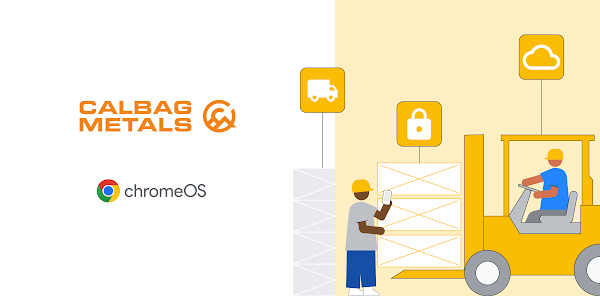Editor’s note: Today’s post is by Jim Perris, Senior Vice President of Finance and Operations for Calbag Metals, a scrap metal recycler and seller based in Portland, Oregon. Calbag adopted ChromeOS devices to simplify the transition to the cloud for their 80-person small business.
Calbag, a buyer, recycler, and seller of scrap metal, is in a commodities business where speed and communication are critical. Specifically, our customers expect our sales team to provide accurate, real-time inventory details and photos of scrap metal available for sale. Delivering against this expectation requires a robust, flexible, and reliable operating system that works across many device types and locations, while being managed centrally by our one person IT team. ChromeOS met all our requirements, enabling our employees to stay productive without the distraction of technical or security challenges.
Simplifying device management
At the time we were considering a change, we had some complicated problems with syncing and integrating files and emails among sales, warehouse, and office workers. The sales people were using many different models of phones, and those of us in the offices and warehouses had PCs with Microsoft Exchange Server, which was going end of life. We had several servers, which didn’t fit in with our goal of simplifying technology or ease of management.
Once we got into ChromeOS more deeply, we realized it would solve several of our IT challenges. By working in the cloud, it would be easier to manage devices across our locations and OEM’s. We also set up shared devices in kiosk mode to connect our entire team.
ChromeOS frees the business from integration headaches
When we adopted Google Pixel phones managed with Android Enterprise, we saw a glimpse of a simpler way to communicate with each other and share files. Realizing how easy it could be, we expanded our Google suite — adding ChromeOS — to eliminate integration problems and to provide us a single platform to access email, applications, and to manage files in Google Drive.
To go with the single ChromeOS platform, we standardized on using Chrome Browser Cloud Management, which gives everyone at Calbag a single place to go to use applications and search for files, like those all-important pictures of scrap metal containers that confirm what we’re buying or selling. No matter which devices people are using — about 50 Pixel phones for our sales people, and 150 ChromeOS devices for everyone else — they can send pictures and deal information, plus files can be easily located and shared via Google Drive or Gmail.
Our primary business application, ScrapIT, only runs as on-premise software, something we’re moving away from as we embrace the cloud. In the meantime, we have no issues accessing ScrapIT using Cameyo and Chrome. This is another way we’ve freed the company from integration problems, since we have options to access almost all of our software apps through the browser.
We can even share devices, something that was much harder before adopting ChromeOS. We ran Linux on Windows PCs that were shared, but that required our two IT people to manually update every device periodically. Today, shared ChromeOS devices in our warehouses run in kiosk mode so employees can log in and track weights and types of scrap metal loads through ScrapIT — no IT maintenance required.
Even our office phones have moved to the cloud. We use Dialpad through Chrome for our business phone system. If anyone needs to work remotely, or if bad weather keeps employees at home, business calls can be routed to any phone being used.
Leaving the security to Google
No business can brush off cyber attacks, but as a smaller business, we’re particularly vulnerable. We can’t afford to lose access to email and files. We’re happy to leave the security to Google. The updates to ChromeOS are automatic and run in the background, so there’s no need to visit every workstation to confirm security. The Google Admin console also plays a part in keeping Calbag secure. We set a list of acceptable apps, and block other apps that we deem are unsafe. If employees want to use a particular Chrome extension or a third-party app, they have to ask us first.
Because our software-as-a-service providers easily integrate with ChromeOS, we added single sign-on and two-factor authentication. It’s good for security, and also for busy employees who don’t have to manage login names and passwords.
Our sales team is always on the go. With Pixel phones managed by Android Enterprise, they no longer need to carry two separate devices. Work Profile lets employees use the same device for work and personal purposes. This allows employees to use their work device in a personal capacity while our team manages and ensures data security over Work Profile.
IT that just works
In a smaller company, conversations about IT tend to happen all the time, because technology can be an ongoing problem. Ten years ago at Calbag, we’d find ourselves talking about IT every day, until the end of the day. Today, we don’t talk about IT, which is exactly what you want. ChromeOS devices do the work behind the scenes allowing Calbag to stay focused on what we do best.
Cloud BlogRead More


